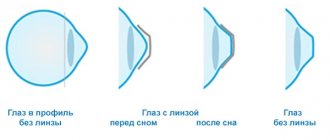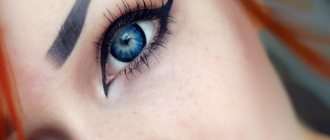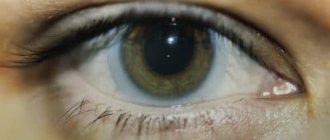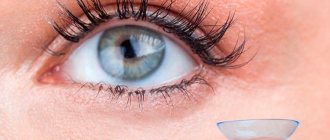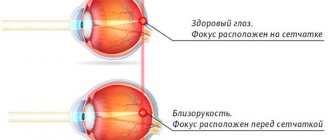The last method in our cycle of vision correction is hard contact lenses for night use. They are the second safest after glasses.
Conventionally, the safest method of correction is definitely glasses (with durable polycarbonate lenses), then ReLEx SMILE and hard night lenses, then femtoLASIK and PRK, then soft daily lenses, then “barbaric methods” - soft long-wear lenses and LASIK. Phakic intraocular lenses and artificial lenses stand separately - they are best done only for direct medical reasons (a fairly invasive method for refractive indications).
The main advantage of night lenses is that they have been clinically proven to stop progressive myopia. Therefore, they are very often prescribed to children when the eye is actively developing. After 20 years, this effect decreases by an order of magnitude, but a couple of other advantages remain.
The price to pay for the obvious advantages is the high price of such lenses, the need for strict discipline and regular sleep of at least 7 hours.
How do night vision correction lenses work?
Night lenses for restoring vision are also called orthokeratology lenses, or OK lenses. The orthokeratology method itself has been developed since the 60s of the 20th century: it was then that optometrist George Jessen first proposed the use of hard contact lenses made of polymethyl methacrylate to correct myopia. Until the 1990s, ophthalmologists conducted clinical trials of rigid lenses, but the results were poorly predictable. And only with the advent of corneal topographers and modern gas-permeable materials for the production of lenses in the 90s was it possible to achieve a stable increase in visual acuity.
The principle of operation of night contact lenses is to flatten the corneal epithelial cells. Optical products are firmly fixed in the eye and press down on the cornea so that it becomes flatter and the image is clearly recorded on the lens of the eye. In this case, the anatomy and integrity of the layers of the cornea are not violated - the method is non-invasive and has practically no contraindications.
Lenses for vision correction should be on the eyes for 6-8 hours. It is most convenient to wear them while sleeping, and it does not matter what time of day the patient sleeps, at night or during the day. The lenses themselves consist of two layers: the first corrects vision, like a regular lens, and the second has a dense structure that allows you to change the shape of the cornea.
The compressed cornea gives the patient the ability to see clearly over the next 24 hours. No additional correction means are needed. However, the effect of eye lenses at night does not last long: the cornea returns to its previous state within 2-3 days, and vision decreases again.
If you regularly wear OK lenses 7-8 hours a day for several months, you can gradually change your schedule and wear them every other night or two.
Validity
Each period of validity of OK lenses is purely individual and depends on the severity of myopia, as well as other third-party effects that may affect the result. However, 1-3 days is a stable period of time during which corrective night lenses can provide vision equal to one.
To maintain diopters at the proper level, OK lenses do not need to be worn every night. The entire cycle consists of 1 day of sleeping with lenses, and the next few days of sleeping without lenses until vision deteriorates. The required period of use is determined by the doctor.
Who is suitable for corrective eye lenses?
Orthokeratology lenses are recommended for patients aged 6 years and older. They are used for the following disorders:
- myopia up to -7 diopters;
- astigmatism up to -1.75 diopters;
- farsightedness up to +4 diopters.
Night lenses are especially often used to restore vision in children: young patients do not have to get used to glasses, they can study, play sports, and play with friends without any difficulties. Moreover: OK lenses prevent further loss of vision.
The orthokeratology method is also used to treat patients who are contraindicated for laser therapy or who, due to the specific nature of their work, cannot wear glasses or contact lenses.
Night lenses for correction do not have an upper age limit, but ophthalmologists recommend them for people under 40-45 years of age. The fact is that age-related vision loss occurs too quickly, so lenses will have to be changed frequently.
Peculiarities
You will notice that the principle of operation of this product is similar to laser correction - the cornea is flattened in the same way as during surgery. However, night lenses for improving vision have one feature - their effect is reversible. That is, after a certain time, the cornea returns to its original position and myopia returns again.
By the way, this is why night lenses for children are considered the best way to correct vision, since the eye is still in the formative stage, and laser surgery is only possible from the age of 18. In addition, it will be more convenient for parents to control the wearing process structured in this way.
How corrective night lenses are selected
Orthokeratology involves individual selection of corrective agents after examining the patient. As a rule, an ophthalmologist prescribes the following procedures:
- Ultrasound of the eye.
- Fundus examination.
- Keratometry.
- Keratotopography.
After the doctor is convinced that there are no contraindications, the parameters of night lenses for the eyes are calculated for optimal vision correction. The first putting on is done under the supervision of an ophthalmologist: he gives instructions on how to properly insert, remove, and care for the products.
To ensure that vision-improving treatment lenses are working as intended, eye doctors ask patients to come back for an appointment after the first night. The doctor examines the eyes, determines visual acuity, and makes sure there is no allergic reaction. After the first use, it is possible to achieve up to 75% of the expected result. The third visit occurs after 1-1.5 weeks, when the lenses are already working at full strength, the fourth - after 1 or 2 months from the start of the correction.
Why should corrective lenses be individual?
The high cost of orthokeratology lenses is explained by the fact that in order to provide the most effective correction, they must be manufactured taking into account the parameters of the cornea of a particular patient. Shape, diameter, curvature matter. An average or, especially, someone else’s lens can worsen vision because it will press on the cornea at the wrong points.
How often does it need to be replaced?
Night lenses for vision correction for children or adults must be changed once a year. As a rule, when re-applying, the price of their production is slightly lower. You can also order only one lens if it gets damaged or lost. Early replacement may be required if:
- the appearance of scratches on the surface;
- cloudiness;
- damage to the edge of the lens;
- the appearance of irremovable plaque.
Selection tips
The selection of night lenses is carried out only by an orthokeratology specialist. When examining a patient, the doctor performs the following diagnostic procedures:
- Keratometry. This is an assessment of the curvature of the anterior surface of the cornea, which is performed to correctly select lenses and determine their optical power, and diagnose keratoconus.
Carrying out the keratometry procedure.
- Keratotopography. This is an examination of the cornea to obtain a topographic map (keratotopogram) of the anterior surface of the cornea. Using this method, the refractive power of the cornea is examined.
- Clarify with the patient whether there are medical contraindications for the use of night lenses.
Only after an orthokeratology specialist has carried out all the necessary diagnostic procedures can you begin to select night lenses. To achieve the best effect from this method of vision correction, you may have to go through many pairs of night lenses.
As a rule, after the first night of use there is no noticeable improvement in visual acuity. To reduce the degree of myopia by 2-3 diopters, you must use night lenses for at least two weeks.
Initially, in the first days of wearing, some visual disturbances may be observed in the form of blurred images, slight double vision, and glare from different light sources. If these side effects do not go away over a long period of time, night lenses must be replaced with other, more suitable ones, or night vision correction must be completely abandoned.
Are there any side effects?
The orthokeratological correction method is one of the safest: complications occur in less than 0.5% of cases.
However, most situations are associated with improper storage, care or wearing of nighttime corrective lenses. 1) Viral conjunctivitis. It manifests itself as tearing, redness, and pain in the eyes. Most often, the reason is hygiene problems: for example, if you put on lenses with dirty hands. You cannot wear night lenses for conjunctivitis: you must first undergo therapy and eliminate all manifestations of the disease, and only then can you return to nighttime correction. 2) Allergy. It can occur both on the material of the lenses themselves (in a small percentage of cases) and on the components of the solution that is used to store them. 3) Sticking to the cornea. This problem can be solved by instilling special drops into the eyes. The reason is insufficient release of tear fluid (dry eye syndrome). 4) Microbial keratitis. This is the most dangerous side effect when microbes that destroy it are introduced to the cornea. The disease manifests itself as cutting pain in the eyes, profuse lacrimation, formation of pus, and photophobia.
If any of these symptoms occur, you should consult a doctor as soon as possible to prevent irreversible loss of vision.
Possible complications
More complex side effects are observed in patients who suffered an eye injury after the prescription of OK therapy, or who did not follow the simplest rules of hygiene. These include:
— erosion;
- swelling;
- inflammation.
Some patients mistakenly believe that night lenses are to blame. Reviews from doctors about this method of correcting myopia indicate the opposite: in most cases, the cause of the occurrence and exacerbation of any eye disease during OK therapy is a late visit to an ophthalmologist and failure to comply with the standard rules for wearing night lenses and visual hygiene.
How long should you wear lenses?
The principle of operation of orthokeratology lenses is to change the shape of the cornea by applying pressure to it.
To achieve the effect, wearing time should be 7-8 hours a day. Optical products are recommended for use during sleep, as they are hard and can cause discomfort. The maximum duration of wear is not limited, but manufacturers do not recommend regularly exceeding 10 hours. If the patient sleeps less than 8 hours, ophthalmologists advise putting on treatment lenses first. The fact is that 4-6 hours will not be enough to flatten the cornea. As soon as the lenses are removed, it will begin to return to its usual shape, and vision will begin to decline. Even if the patient does not immediately notice changes in visual acuity, he may experience fatigue, dizziness, and headache.
How much do night lenses cost to restore vision?
Vision-correcting lenses are significantly more expensive than traditional ones: the price of one pair starts from 20 thousand rubles. Additionally, you will need product care products: storage solution, eye drops, suction cup manipulator. You should also take into account that when you first visit the clinic, you will need to undergo a full vision test: the examination will cost an average of 10-15 thousand rubles. After the manufacture of OK lenses, 2-3 visits to the ophthalmologist are necessary to ensure that the correction is effective and there are no contraindications.
The best manufacturers of products for orthokeratology correction are Paragon CRT, MoonLens and Emerald Topaz. These are the lenses that are on sale in most Moscow clinics.

